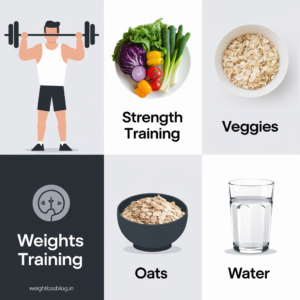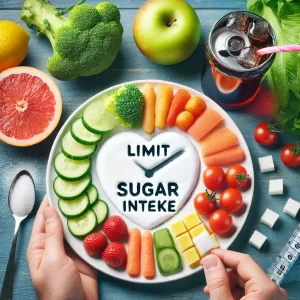How to Lose Weight and Control Hypertension with the DASH Diet: A Comprehensive Guide
Introduction to the DASH Diet
The DASH Diet (Dietary Approaches to Stop Hypertension) is one of the most recommended diets for individuals looking to manage their blood pressure and improve overall heart health. Originally designed to lower blood pressure, the DASH Diet has also been found to be effective for weight loss, making it an ideal choice for those seeking to achieve a healthy weight while reducing their risk of heart disease. It emphasizes nutrient-rich, whole foods while limiting sodium, unhealthy fats, and added sugars. For anyone looking  for a blood pressure control diet, this guide will show how the DASH Diet works and why it’s a great approach to weight loss.
for a blood pressure control diet, this guide will show how the DASH Diet works and why it’s a great approach to weight loss.
How the DASH Diet Works for Weight Loss
The DASH Diet is designed to promote heart health by reducing sodium intake and increasing the consumption of nutrient-rich foods like fruits, vegetables, lean proteins, and whole grains. These foods are naturally low in calories and high in nutrients, making them excellent choices for weight loss. By following a sodium reduction diet, you can reduce water retention and help your body regulate blood pressure more effectively.
The DASH Diet focuses on portion control and balanced meals, encouraging a gradual reduction in calorie intake. It does not rely on extreme restrictions or eliminating food groups, making it more sustainable than many other diets. The emphasis on whole, minimally processed foods makes it easier to stick to a healthy eating pattern, promoting long-term weight management and overall well-being.
Allowed and Restricted Foods
The DASH Diet encourages a wide variety of foods while limiting those high in sodium, unhealthy fats, and added sugars. Here’s a breakdown:
- Allowed Foods: Fresh fruits and vegetables, whole grains, lean proteins like chicken and fish, low-fat dairy products, nuts, seeds, and legumes. The diet encourages the consumption of potassium-rich foods like bananas, sweet potatoes, and spinach, which help balance sodium levels in the body.
- Restricted Foods: Processed and packaged foods, salty snacks, sugary drinks, red meat, full-fat dairy products, and foods high in saturated and trans fats. Sodium intake should be limited to 1,500–2,300 mg per day, depending on individual health needs.
Benefits of the DASH Diet for Weight Loss and Hypertension
The DASH Diet is known for its ability to improve heart health, but it also offers several benefits for weight loss. Here are some key advantages:
1. Promotes Healthy Blood Pressure
The DASH Diet was initially developed to help lower high blood pressure, or hypertension, by reducing sodium intake and increasing nutrient-rich foods. Studies have shown that following the DASH Diet can significantly reduce both systolic and diastolic blood pressure, which is crucial for preventing heart disease and stroke.
2. Supports Sustainable Weight Loss
By focusing on whole, nutrient-dense foods and limiting processed, high-calorie options, the DASH Diet naturally promotes weight loss. The diet is balanced, providing a variety of foods that keep you  full and satisfied without the need for calorie counting or extreme restriction.
full and satisfied without the need for calorie counting or extreme restriction.
3. Reduces Risk of Heart Disease
In addition to lowering blood pressure, the DASH Diet improves cholesterol levels by reducing LDL (bad) cholesterol and increasing HDL (good) cholesterol. This reduces the risk of developing heart disease, particularly when combined with regular physical activity and other healthy lifestyle choices.
4. Improves Overall Nutrition
The DASH Diet emphasizes a variety of nutrient-rich foods, including fruits, vegetables, and whole grains, which provide essential vitamins, minerals, and fiber. This helps support digestion, immune function, and overall health, making it easier to maintain a healthy weight and avoid nutritional deficiencies.
Potential Drawbacks of the DASH Diet
While the DASH Diet is beneficial for most people, there are a few potential drawbacks to consider:
1. Requires Meal Planning and Preparation
Because the DASH Diet emphasizes fresh, whole foods, it requires more meal preparation than diets that rely on processed, convenient foods. For busy individuals, this may be challenging, but planning ahead and preparing meals in bulk can make it more manageable.
2. Limited Sodium Intake Can Be Challenging
For those who are used to a high-sodium diet, reducing salt intake can be difficult at first. However, with time, your taste buds will adjust, and you’ll begin to enjoy the natural flavors of food without added salt.
Tips for Success on the DASH Diet
To succeed on the DASH Diet and achieve your weight loss goals, consider the following tips:
1. Start with a Simple Meal Plan
If you’re new to the DASH Diet, start with a simple DASH diet meal plan for weight loss that includes easy-to-prepare meals. Focus on incorporating more fruits, vegetables, and lean proteins into your diet, and gradually reduce your sodium intake over  time.
time.
2. Incorporate Physical Activity
While the DASH Diet is effective on its own, combining it with regular physical activity can accelerate weight loss and improve overall cardiovascular health. Aim for at least 150 minutes of moderate exercise per week, such as walking, swimming, or cycling.
3. Stay Hydrated
Proper hydration is key to maintaining a healthy weight and controlling blood pressure. Drink plenty of water throughout the day to support digestion and keep your energy levels up, especially if you’re reducing your sodium intake.
4. Monitor Portion Sizes
Although the DASH Diet encourages healthy foods, it’s important to practice portion control to avoid overeating. Use smaller plates, measure your portions, and be mindful of how much you’re consuming, especially with higher-calorie foods like nuts and dairy.
Scientific Evidence Supporting the DASH Diet
The DASH Diet is backed by numerous scientific studies showing its effectiveness for lowering blood pressure and promoting heart health. A study published in the New England Journal of Medicine found that participants who followed the DASH Diet experienced significant reductions in blood pressure, even without reducing sodium intake. When combined with lower sodium intake, the effects were even more pronounced.
Another study published in the Journal of the American Medical Association demonstrated that the DASH Diet reduces the risk of cardiovascular disease and stroke, particularly in individuals with hypertension. These findings highlight the importance of adopting a diet that promotes both heart health and weight management.
Who Should Try the DASH Diet?
The DASH Diet is an excellent choice for individuals who:
- Want to lose weight while improving heart health and reducing the risk of hypertension.
- Are looking for a long-term, sustainable diet that emphasizes whole, unprocessed foods.
- Prefer a balanced approach to eating without extreme restrictions or calorie counting.
- Need to reduce sodium intake for better blood pressure control.
Who Should Avoid the DASH Diet?
While the DASH Diet is suitable for most people, it may not be ideal for:
- Individuals who prefer higher-sodium foods or have difficulty following a low-sodium diet.
- People with specific medical conditions that require different dietary approaches.
- Those who prefer very low-carb or high-protein diets, as the DASH Diet includes moderate amounts of carbohydrates and limits certain proteins like red meat.
Conclusion
The DASH Diet is a heart-healthy, sustainable way to lose weight while reducing the risk of hypertension and heart disease. By following a DASH diet meal plan for weight loss, focusing on whole foods, and reducing sodium intake, you can improve your overall health and achieve your weight loss goals without extreme restrictions. Whether you’re looking to control blood pressure or simply adopt a healthier way of eating, the DASH Diet offers a balanced and scientifically backed approach to better health.